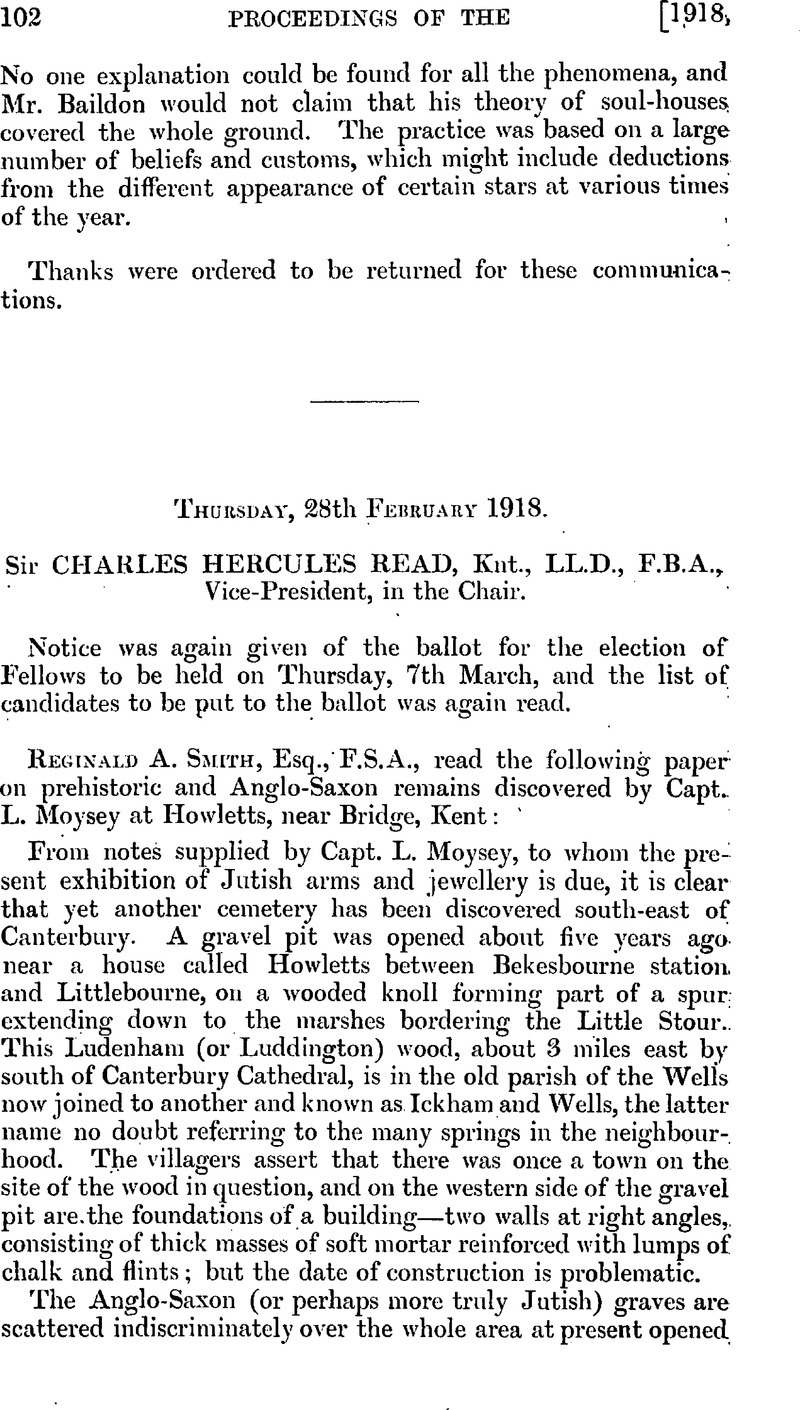Article contents
Thursday, 28th February 1918
Published online by Cambridge University Press: 10 May 2010
Abstract

- Type
- Proceedings
- Information
- Copyright
- Copyright © The Society of Antiquaries of London 1918
References
page 103 note 1 See on this point Baldwin Brown, The Arts in Early England, vol. iii, pp. 583, 695, 726.
page 104 note 1 Professor Baldwin Brown has wrestled with the problem but has got no definite results (The Arts in Early England, iv, 544). Compare two Ipswich specimens in Proceedings, xxi, 242, 247.
page 104 note 2 F. Moreau, Collection Caranda. (Aisne), ii, pl. 10 (N.S.), fig. 8; and Boulanger, Mobilier funéraire, pl. 26, fig. 25.
page 105 note 1 This form occurred at Sarre (Arch. Cant., vii, pl. xiii, grave lxiv), but the nature of the socket is not stated.
page 107 note 1 B. Brown, op. cit. iii, pl. xxxv, 10, and pl. xli, 2 (late fifth century). Their occurrence is discussed on p. 718.
page 107 note 2 Cf. Schetelig, Cruciform Brooches of Norway, figs. 45, 55, 72, 91, 92, etc.
page 109 note 1 Called in this neighbourhood the Nailbourne, as the stream is often lost below Bridge and rises again half-way between Bekesbourne and Littlebourne, much in the same way as the Mole sinks for a while in the chalk south of Leatherhead (W. Whitaker, Geology of the London Basin, 1872, p. 392, and Rice Holmes, Ancient Britain, 679).
page 113 note 1 Proc. Geol. Assoc., xxvi (1915), p. 6Google Scholar.
page 116 note 1 Very like a pair found complete, of the same diameter, at Newport Pagnell, Bucks., in 1899.
page 117 note 1 Cf. Baldwin Brown, op. cit., iii, 263, pl. xli, fig. 2 (Malton Farm, Cambs.), late fifth century.
page 120 note 1 Proceedings, xx, 344 ; cf. Opuscula archaeologica Oscari Montelio dicata 1913), p. 281.
page 121 note 1 The woodblock in Wilde's Catalogue, reproduced in the R. I. A. Christian Guide, has been reversed in the process.
page 121 note 2 Proc. Royal Irish Academy, iii (1845), 135.
page 121 note 3 Archaeologia, xvi, 348 (British Museum) ; cf. Proceedings, xx, 34.
page 121 note 4 Archaeological Journal, xxvii, 97 ; now in Taunton Castle museum.
page 123 note 1 Archaeologia, xlvi, pl. xxiv, figs. 16, 17.
page 123 note 2 They are included as such in Gen. Pitt-Rivers's volume. Primitive Locks and Keys (1883), pl. iv, figs. 40b, 41b; see p. 12.
page 125 note 1 This explanation is confirmed by the presence of a wire coil on a penannular brooch (R. I. A. Christian Guide, fig. 27, see p. 23) of about a. d. 550.
page 126 note 1 Ulster Journ. of Arch., ix (1903), 160Google Scholar.
page 127 note 1 Col. Wood-Martin noticed in some cases that the loops of the pin were worn smooth by friction with these coils.
- 1
- Cited by




